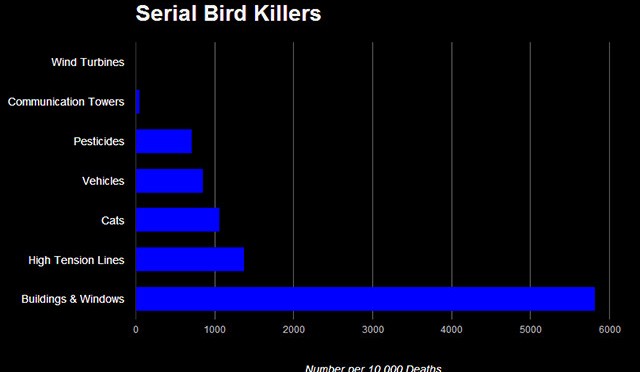Wind is considered one of the cleanest means of harnessing energy. Unlike traditional power sources, wind energy is free of pollutants such as particulates, methane, mercury, sulfur dioxide and nitrogen oxides. No fuel is required for mining or drilling, billions of gallons of water are not consumed during operation, and minimal amounts of waste are produced. As the worldwide demand for sustainable energy grows, thousands of wind turbines are being installed each year.
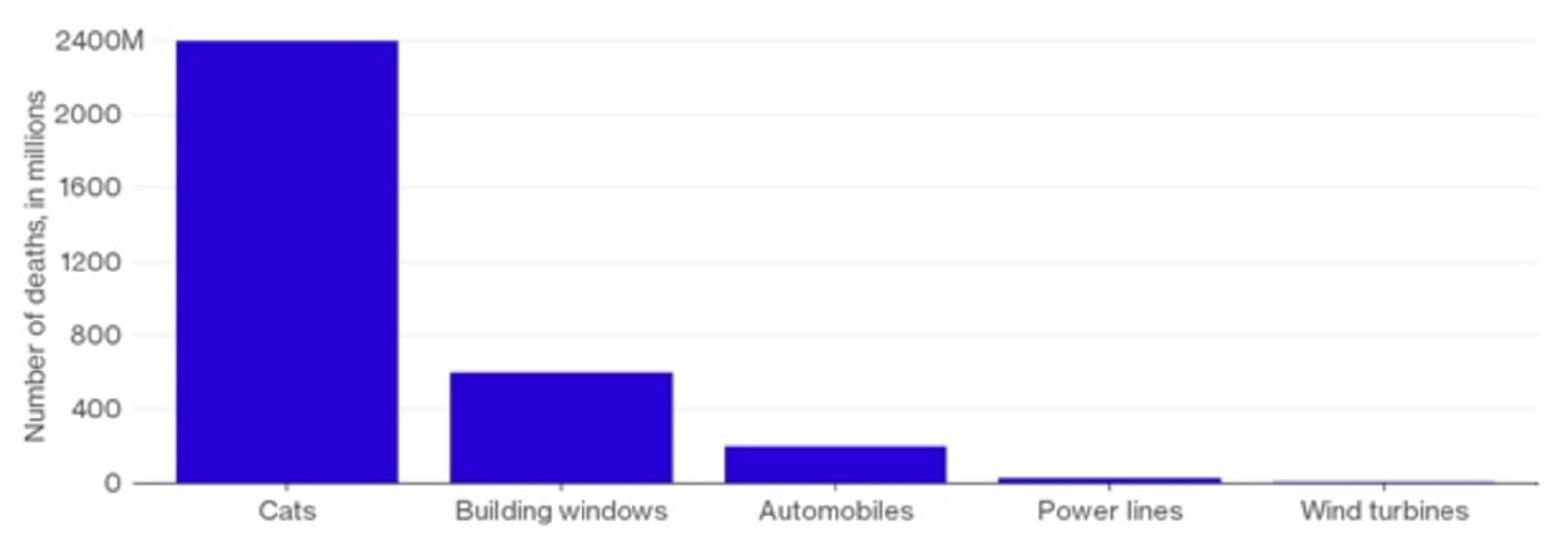
It is unfortunate then that wind energy has its own dark side: thousands of birds and bats are killed annually by wind turbines. Causes of death include collision and barotrauma—internal injuries caused by exposure to rapid pressure changes near the trailing edges of moving blades.
The U.S. Fish and Wildlife Service estimates that between 140,000 and 500,000 bird deaths occur at wind farms each year. The most significant threat is posed to species of large, threatened and high-conservation-value birds such as golden and bald eagles, burrowing owls, red-tailed and Swainson’s hawks, peregrine and prairie falcons, American kestrels and white-tailed kites. Since large birds have much lower reproductive rates than small birds (golden eagles, for example, have just one or two chicks in a brood less than once a year), their deaths have a far greater impact on the overall population of the species.
Wind turbines have also been found to be one of the leading causes of mass bat mortality—with some studies pinning fatalities at 888,000 bats a year.
“Unprecedented numbers of migratory bats are found dead beneath industrial-scale wind turbines during late summer and autumn in both North America and Europe,” says Paul Cryan, a research biologist with the U.S. Geological Survey. “There are no other well-documented threats to populations of migratory tree bats that cause mortality of similar magnitude to that observed at wind turbines.”
Bats may not be many people’s favorite creatures, but they play an important role in the planet’s ecosystems. Not only do the aerial mammals consume hordes of pest insects—they’re also instrumental in pollinating flowers and dispersing seeds to regenerate rainforests.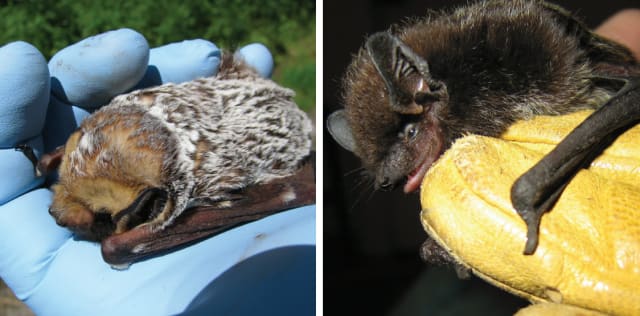
In North America, tree bats comprise around 75 percent of bat species affected by turbines, with hoary bats making up half of all fatalities. According to the journal Biological Conservation, the hoary bat population could be at risk of extinction due to mortality from wind turbines. Like large birds, bats are long-lived mammals with low reproductive potential, requiring high adult survivorship to maintain populations. The widespread fatalities of hoary bats at wind turbines could (literally) cut down the hoary bat population by as much as 90 percent in the next 50 years.
Wind’s Practical Solutions for Birds
Unlike previous years, wind energy companies are now responsible for completing environmental impact assessments (EIAs) prior to the installation of wind turbines in an area. Bird migratory routes are avoided, and vegetation surveys are conducted underneath turbines to ensure that none of the migratory birds’ preferred food sources are present. In Spain, some wind energy companies even shut down wind farms when large numbers of migrating birds approach.
A 2019 study published in the Journal of Environmental Management describes mitigation measures involving superficially tilling the soil around the base of wind turbines—making the area less attractive to kestrels due to the consequent reduction of prey around the turbines. The result? A 75–100 percent decline in collisions over a period of two years.
Even more recently, Norwegian scientists have discovered that painting one of the three blades on a wind turbine black reduces avian deaths by 72 percent.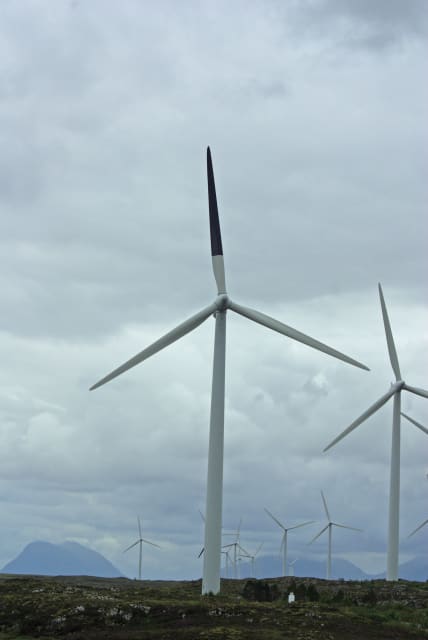
The research was conducted by the Norwegian Institute for Nature Research over the span of a decade—from 2006 to 2016—at the Smøla wind farm on a bird-rich island off Norway’s west coast. In 2013, four turbines had a single blade painted black, and bird deaths were recorded for the years before and after the paint job. The resulting data showed a dramatic reduction in the annual fatality rate at the painted turbines relative to the control (i.e., unpainted) turbines.
The scientists behind the study have a theory for why birds are susceptible to flying into rotating turbine blades and why a single black blade helps them to perceive the wind turbine as an obstacle.
“Relative to humans, birds have a narrow binocular [using both eyes to focus on one object] frontal field of view and likely use their monocular [using each eye independently] and high?resolution lateral fields of view [having eyes on opposite sides of their heads] for detecting predators, conspecifics [birds of the same species] and prey,” explain the authors of the study. “Within an assumed open airspace, birds may therefore not always perceive obstructions ahead, thereby enhancing the risk of collision. To reduce collision susceptibility, provision of ‘passive’ visual cues may enhance the visibility of the rotor blades, enabling birds to take evasive action in due time.”
In other words, birds may be perceiving the rotating white blades as a “motion smear” rather than as a moving object—much like the blur effect humans see when waving a hand quickly in front of their eyes. Once a blade is painted black, the birds correctly distinguish the motion patterns as a moving object.
Innovations to Protect Bats
In order to develop practical solutions for reducing bat deaths around wind turbines, it is essential to understand the causes of the collisions. While aggregation during migration prevails as the most common source of mortality, many studies suggest that bats may be attracted to turbines out of curiosity, misperception, or as potential feeding, roosting and mating opportunities.
“Oftentimes, acoustic monitoring before construction of a wind facility may not show much bat activity, but this increases after the facility is built, as if the bats were drawn there,” reveals Sara Weaver, a biology lecturer at Texas A&M University–San Antonio.
It is promising then that researchers at Texas State University and Bat Conservation International have found an innovative solution to discourage bats from entering wind turbine airspaces: a bat deterrent system that jams bats’ echolocation capabilities with ultrasound.
Bats emit a high frequency call that is reflected off of objects, including their prey. They rely on the return echo to determine the distance and direction of their prey, enabling them to navigate and forage in the dark.
The bat deterrent system, manufactured by NRG Systems, utilizes a set of speakers to produce an ultrasonic acoustic field at a pitch of 20–50 kHz—the same range as bats’ natural echolocation frequencies. This interferes with their ability to receive and interpret their own echolocation calls and creates an airspace that is difficult to navigate, forcing the bats to give up and leave the area. Data collected over two years demonstrates that NRG’s bat deterrent technology curbed bat fatalities by 54 percent, with particularly positive results for Brazilian free-tailed bats and hoary bats.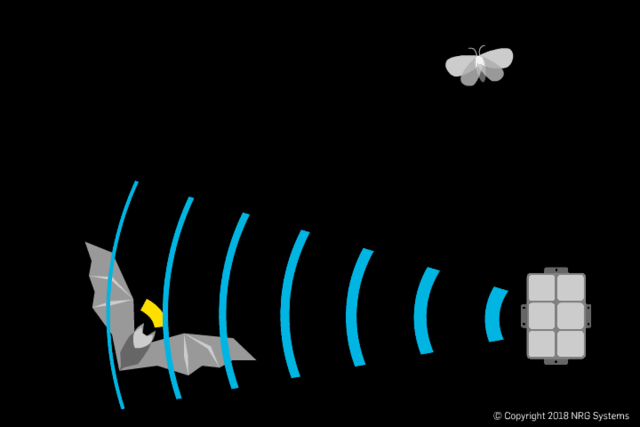
Interestingly, the idea is based on echolocation jamming in nature. Certain tiger moths protect themselves from becoming bat food by emanating ultrasonic clicks that interfere with the bats’ echolocation.
In case environmentalists were concerned, the technology won’t push bats out of their natural habitat either. The bat deterrent system only covers the rotor swept area of the turbine, so bats foraging below that level are completely unaffected. Furthermore, there is no risk of habituation where the speakers lose their effectiveness as bats get used to them (think of a bird perched on a scarecrow). Instead of simply annoying or scaring bats, the technology compromises the echolocation capabilities on which bats are heavily reliant.
The researchers concede that the technology may, however, have certain limitations.
“One challenge would be the physics of sound propagation at high frequencies,” says Aaron Corcoran, a research assistant professor at Wake Forest University. “Ultrasound attenuates very rapidly in air.”
Lower frequencies are more likely to dissipate further than higher ones, leading to a species-specific response where the technology works better to protect bats that echolocate on the lower end of the ultrasonic spectrum.
Another creative approach for preventing bat deaths at wind turbines involves the use of 3D-printed echolocation whistles modeled after the bat larynx. These lightweight whistles can be mounted on turbine blades to passively generate ultrasonic sounds as bat warning signals without the need for a power source.
By producing noises that are easily recognizable by bats at distances of over 100 meters, the whistles allow bats more time to alter their flight path and avoid colliding with rotating turbine blades. The project is spearheaded by researchers at Texas A&M University and the University of Massachusetts Amherst, and is partially funded by the U.S. Department of Energy in an effort to protect wildlife at wind farms.
According to the research team, the 3D-printed whistles can be designed for a wide range of bat species due to the variety of bat larynges present in different types of bats. It is, of course, necessary that the sounds warn bats to stay away instead of accidentally having the opposite effect where bats are attracted to the wind turbines. Nature-friendly AI tools can help in this matter—such as an open-source machine-learning algorithm developed by South American scientists for the acoustic identification of bat species. With a library of 662 search phase pulses, the algorithm is already being used by wind energy companies to carry out environmental impact studies on wind farms.
A Greater Perspective
If we’re looking at the bigger picture, wind power’s impact on bird populations is relatively small when compared with other human-related sources of avian mortality. Numerous studies demonstrate that far more bird deaths are caused by collisions with buildings (676 million), vehicles (214 million), and power lines (32 million) in the United States. (It should be taken into consideration, though, that birds killed by wind turbines have historically been of higher conservation value than the robins and sparrows killed by non-wind-related sources.)
Even with its relatively low impacts, the wind industry holds itself to a higher standard and does more to mitigate wildlife damages than any other energy industry. Wind developers constantly evaluate risks to birds before projects are sited, adjusting wind farm design, turbine location and project operations to reduce potential harm. The wind industry follows the U.S. Fish and Wildlife Service’s Land-Based Wind Energy Guidelines—and as a result, over 90 percent of American wind farms now have zero eagle deaths.
In 2008, the U.S. wind industry collaborated with nationwide conservation organizations such as the National Audubon Society and National Wildlife Federation to establish the American Wind and Wildlife Institute, which addresses wind and wildlife concerns. The organization has published issue briefs on protecting bats, for instance—with suggestions to implement curtailment (the intentional halting of turbine blades) when wind speeds are low in order to reduce bat fatalities by 50 percent.
In the end, it’s climate change that causes the most significant threat to wildlife. According to the United Nations, climate change may contribute to the extinction of 20–30 percent of all species by 2030. Renewable wind energy can play a major role in displacing sources of energy that contribute to high carbon emissions, and its advantages have been proven to outweigh its impact on birds and bats.
“Saying wind power can only be green if there are no impacts is like saying medicine can only be effective if it has no side effects,” says John Anderson, director of siting policy for the American Wind Energy Association. “At some point, we need to put the benefits and risks into context.”
engineering.com
